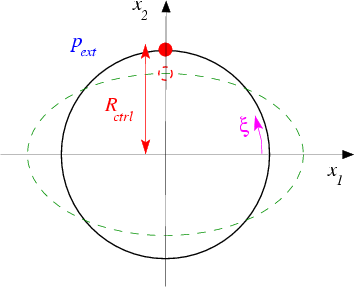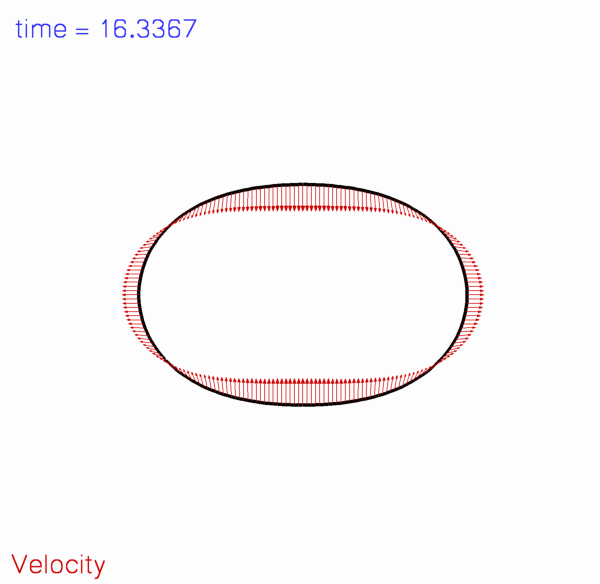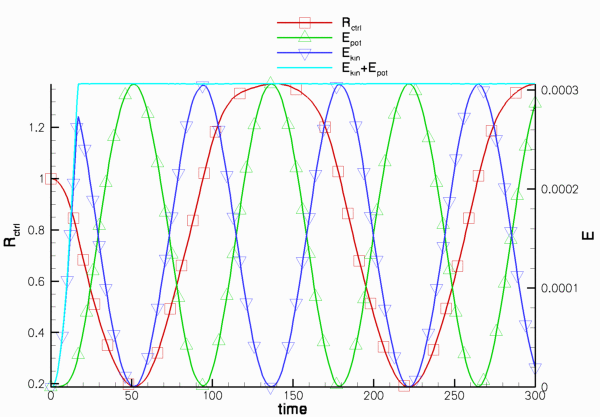In this document we discuss the solution of a time-dependent beam problem: The large-amplitude oscillations of a thin-walled elastic ring. Specifically we shall
- demonstrate how to specify initial conditions for time-dependent simulations with
oomph-lib'sKirchhoffLoveBeamelements, - demonstrate how to use the
dump/restartfunctions forKirchhoffLoveBeamelements, - show that timesteppers from the
Newmarkfamily- can be used with variable timesteps,
- conserve energy,
- can allocate and maintain storage for the solution at previous timesteps.
We wish to compute the large-amplitude oscillations of a linearly-elastic, circular ring of undeformed radius
which initiates an oscillation in which the ring deforms into a non-axisymmetric mode, as indicated in the sketch below: 
Sketch of the buckling ring. We choose the same non-dimensionalisation as in the previous steady example and parametrise the position vector to the ring's undeformed centreline as
where the non-dimensional arclength |
Results
The figure below shows a snapshot, taken from an animation of the ring's computed deformation for a wall thickness of 



The red line with square markers in the figure below shows the time-history of the ring's control displacement: At 







The remaining lines in the plot show the ring's kinetic and potential (i.e. the strain) energy and their sum. Up to 
Global parameters and functions
As usual, we employ a namespace to define the problem's physical parameters and the load that acts on the ring. For the pressure loading defined in equation (1), the load is given by
![\[
\mathbf{f} = -P_{cos}\cos\left(2\xi\right)\mathbf{N},
\]](form_19.png)
where 
We also define the non-dimensional wall thickness 

The driver code
The main function is very simple. We store the (up to) two optional command line arguments which (if present) specify (i) a flag that indicates if the code is run in validation mode, and (ii) the name of a restart file.
Next, we build the problem with thirteen HermiteBeamElements and a Newmark<3> timestepper ( recall that a Newmark<NSTEPS> timestepper allocates and manages storage for the solution at NSTEPS previous timesteps; we shall illustrate this capability in the section How to retrieve the solution at previous timesteps ), before executing the timestepping loop.
The problem class
The problem class is very similar to that used in the previous, steady example , but includes a few (obvious) additional functions that specify the initial conditions (Setting the initial condition) and perform the timestepping (The timestepping loop). We also provide two functions that allow us to dump the solution to disk (Writing a restart file) and to restart the time-dependent simulation (Restarting from a file).
The private member data includes an output stream that we shall use to write a trace file. The two boolean flags indicate if the code is run in validation mode, and if the simulation has been restarted, respectively.
The problem constructor
The constructor assigns default values for the two control flags corresponding to a non-validation run without restart. We create a timestepper of the type specified by the template parameter and add it to the Problem's collection of timesteppers.
Next we build the geometric object that defines the shape of the ring's undeformed centreline (an ellipse with unit half axes, i.e. a unit circle) and use it to build the mesh. As in the previous steady example we exploit the symmetry of the deformation and only discretise a quarter of the domain.
The boundary conditions are identical to those in the steady example.
Finally, we pass the pointers to the load function and the pointer to the geometric object that specifies the ring's initial shape to the elements and assign the equation numbers.
Post-processing
We compute the total kinetic and potential (=strain) energies stored in the (quarter-)ring and document them, their sum, and the control radius in the trace file.
Next we use the default output function to document the ring shape and add a few tecplot commands to facilitate the animation of the results.
How to retrieve the solution at previous timesteps
The next few lines illustrate how to retrieve (and document) the ring shape at previous timesteps. Recall that Newmark timesteppers are implicit, single-step timestepping schemes that compute approximations for the time-derivatives, based on the solution at the current time level, and on "history values" that represent quantities at a single previous timestep. In some applications (particularly in fluid-structure interaction problems) it is necessary to keep track of the solution at additional previous timesteps. Storage for such additional history values is allocated (and managed) by the generalised Newmark<NSTEPS> timesteppers if NSTEPS > 1. We stress that these additional history values are not involved in the approximation of the time-derivatives; they are simply stored and updated by the timestepper when the solution is advanced to the next timestep.
Recall also that the member function TimeStepper::nprev_values() may be used to determine how many of the history values that are stored in an associated Data object represent the solution at previous timesteps. Finally, recall that history values that represent the solution at previous timesteps are always stored before those that represent "generalised" history values (such as approximations of the first time-derivative at the previous timestep, etc). It is therefore always possible to determine how many previous solutions are stored in a Data object, and where they are stored.
To document the shape of a HermiteBeamElement at a previous timestep, the HermiteBeamElement provides an additional three-argument output function that may be called as follows:
At timestep t, these statements create the output files RESLT/ring t-0, .datRESLT/ring t-1, .datRESLT/ring t-2, .datRESLT/ring t-3, which contain the shape of the ring at the .datt -th, ( t -1)th, ( t -2)th and
( t -3)th, timestep, respectively.
Finally, we write a restart file that will allow us to restart the simulation.
Writing a restart file
Writing the restart file for the present problem is as easy as in the previous examples, as the generic Problem data may again be written with the Problem::dump(...) function. We customise the restart file slightly by adding the value 
Restarting from a file
The restart operation reverses the steps performed in the dump function: We recover the two problem-specific parameters and then read the generic Problem data with the Problem::read(...) function.
Setting the initial condition
The assignment of initial conditions depends on whether or not a restart from a previous computation is performed. If no restart is performed, we specify the initial timestep, dt, and assign history values that are consistent with an impulsive start from the ring's initial shape.
If the computation is restarted, the name of the restart file will have been specified on the command line. We try to open the restart file
and display an error message and terminate the program execution if the file cannot be opened.
If the file can be opened we call the restart function which returns the the Problem into the state it was in when the restart file was written. No further steps are required.
The timestepping loop
We start by converting the (optional) command line arguments into the flags that determine what mode the code is run in: Without command line arguments, we use the default assignments, as specified in The problem constructor.
A single command line argument is interpreted as the "validation run" flag (1 for true, 0 for false) which will be used to limit the number of timesteps.
The presence of two command line arguments indicates that a restart is performed. In this case the second argument specifies the name of the restart file.
We print an error message if the code is run with any other number of command line arguments.
We create a DocInfo object to specify the name of the output directory, and open the trace file.
Next, we set the problem parameters and the number of timesteps to be performed, before assigning the initial conditions.
The timestepping loop itself is practically identical to that used in driver codes for other unsteady problems. To demonstrate that Newmark timesteppers can deal with variable timesteps, we reduce the timestep slightly after every step.
Comments and Exercises
The default non-dimensionalisation of time
The non-dimensionalisation of the principle of virtual displacements that forms the basis of oomph-lib's beam elements, was discussed in detail in an earlier example. However, since this is the first time-dependent beam problem it is worth re-iterating that, by default, time is non-dimensionalised on the timescale for extensional deformations i.e. on the natural timescale
![\[
{\cal T}_{natural} = {\cal L} \sqrt{\frac{\rho}{E_{eff}}}
\]](form_24.png)
of oscillations in which the beam is stretched/compressed along its centreline. The relation between the dimensional time 

![\[
t^* = \underbrace{{\cal L}
\sqrt{\frac{\rho}{E_{eff}}}}_{{\cal T}_{natural}} \ t,
\]](form_27.png)
where 





This non-dimensionalisation of time is consistent with the non-dimensionalisation of all stresses/loads on 
The default non-dimensionalisation for the kinetic and potential (strain) energies
With the default non-dimensionalisation discussed above, the non-dimensional kinetic and potential (strain) energies are given by
![\[
\Pi_{strain} = \frac{\Pi_{strain}^*}{{\cal L} \, h^* E_{eff} } =
\frac{1}{2}\int \left( \gamma^2 +
\frac{1}{12}\left(\frac{h^*}{{\cal L}}\right)^2
\kappa^2 \right) \ d \xi
\]](form_35.png)
and
![\[
\Pi_{kin} = \frac{\Pi_{kin}^*}{{\cal L} \, h^* E_{eff}}
= \frac{1}{2}
\int
\frac{\partial {\bf R}_w}{\partial t} \cdot
\frac{\partial {\bf R}_w}{\partial t} \ d \xi,
\]](form_36.png)
respectively. Conservation of energy implies that
![\[
\Pi_{kin} + \Pi_{strain} = const.
\]](form_37.png)
if there is no external forcing. The plot of the energies shown at the beginning of this document shows that the time-integration with the Newmark method is energy-conserving.
Changing the timescale used to non-dimensionalise the equations
It is possible to non-dimensionalise the governing equations on a different timescale, 
![\[
t^* = {\cal T} \ t.
\]](form_39.png)
This is achieved by overwriting the default assignment for the ratio
![\[
\Lambda = \frac{{\cal T}_{natural}}{{\cal T}} =
\frac{{\cal L}}{{\cal T}} \sqrt{\frac{\rho}{E_{eff}}},
\]](form_40.png)
of the natural timescale 

By default, we have 
may be used to assign a different value for the square of the timescale ratio which may also be interpreted as the non-dimensional density. The case 



...and passing a pointer to 
The definition of the non-dimensional kinetic energy used in KirchhoffLoveBeamEquations::get_energy(...) incorporates the timescale ratio by computing the non-dimensional kinetic energy as
![\[
\Pi_{kin} =
\frac{\Pi_{kin}^*}{{\cal L} \, h^* E_{eff}} =
\frac{1}{2} \Lambda^2
\int
\frac{\partial {\bf R}_w}{\partial t} \cdot
\frac{\partial {\bf R}_w}{\partial t} \ d \xi
\]](form_45.png)
which, for the default assignment 
Exercises
- As discussed in The default non-dimensionalisation of time , the period of the oscillation (


Change the load function to a spatially-constant external pressure (which will deform the ring axisymmetrically so that its motion is dominated by extensional deformations) to confirm that in this mode

- the period of the axisymmetric oscillations is

- Use the principle of virtual displacements (without prestress)
to show (analytically) that for bending-dominated deformations (i.e. deformations for which![\[
\int_0^{L} \left[
\gamma \ \delta \gamma +
\frac{1}{12} h^2 \kappa
\ \delta \kappa -
\left(\frac{1}{h} \sqrt{\frac{A}{a}} \ {\bf f} - \Lambda^2
\frac{\partial^2 {\bf R}_w}{\partial t^2} \right) \cdot
\delta {\bf R}_w
\right] \ \sqrt{a} \ d\xi = 0,
\ \ \ \ \ \ \ \ \ (2)
\]](form_50.png)

- an increase in the wall thickness

- reduce the amplitude of the ring's static deformation by a factor of 8 (thicker rings are stiffer)
- reduces the period of the unforced oscillations (i.e. the oscillations it performs when

- an increase in the ring's density







Global_Physical_Variables::Alphaand repeat the computation. - an increase in the wall thickness
- Confirm that the restart procedure works correctly by plotting the time-trace obtained from a restarted simulation on top of the original time-trace.
- Compare the results obtained from a simulation with a variable timestep against the results obtained from a computation with a fixed timestep (comment out the line that reduces the timestep after every solve).
- Compare the various output files generated in
doc_solution()to confirm that theNewmark<3>timestepper correctly maintains the history of the solution at three previous timesteps. E.g. confirm that the output fileRESLT/ring3-0.datwhich contains the ring shape at timestep 3 is identical toRESLT/ring5-2.datwhich contains the ring shape computed two timesteps before timestep 5. Exploreoomph-lib'sinternal use of the history values by analysing the functionsHermiteBeamElement::output(...)andFiniteElement::interpolated_x(...)FiniteElement::x_gen(...)
Source files for this tutorial
- The source files for this tutorial are located in the directory:
demo_drivers/beam/unsteady_ring/ - The driver code is:
demo_drivers/beam/unsteady_ring/unsteady_ring.cc
PDF file
A pdf version of this document is available.


![\[
p_{ext}\left(\xi ,t \right) =
\left\{
\begin{array}{ll}
-P_{cos}\cos\left(2\xi\right) & \mbox{for $t<T_{kick}$} \\
0 & \mbox{for $t>T_{kick}$}
\end{array}
\right.
\mbox{\ \ \ \ \ \ \ \ \ \ (1) }
\]](form_2.png)
![\[
{\bf r}_w(\xi) = {\bf R}_w(\xi,t=0) = \left(
\begin{array}{c}
\cos(\xi) \\
\sin(\xi)
\end{array}
\right),
\]](form_3.png)
![$ \xi \in [0,2\pi] $](form_4.png)


